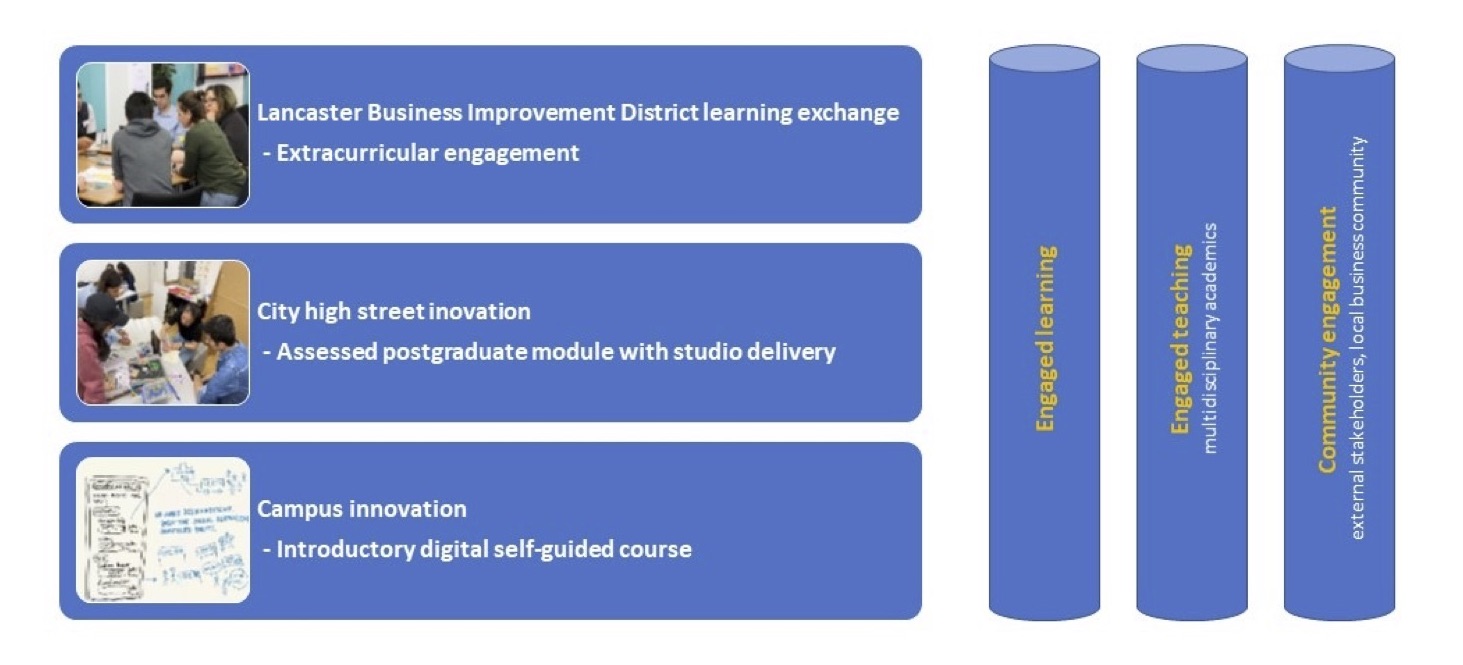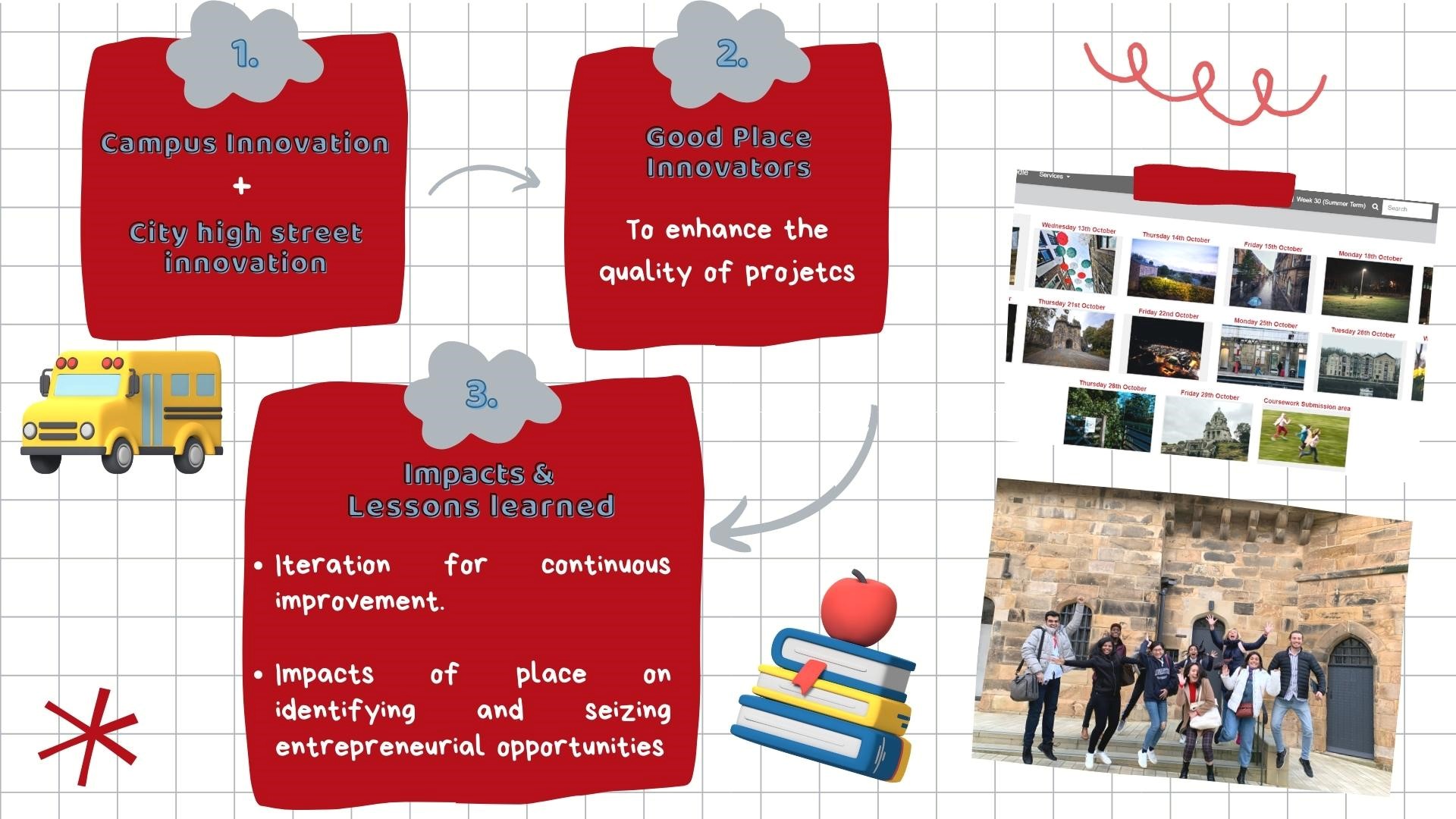Spaces for Solidarity: Fostering collaboration and inspiring inclusive education
1. Wandering the streets of Lancaster, fieldwork in management curriculum
Welcome to our session! Get comfy and let’s start with a little observation exercise (e-tivity). Below you will see a reel of photographs taken on Lancaster University Campus. Flick through and answer the following questions on padlet clicking HERE.
- What is one thing you observe – don’ t try to make sense of it, just observe and describe what you see.
- Why might this be happening? – add your interpretation, empathise with these students you see and focus on possible challenges and frustrations of these students you see on the photos.
- This inspires me to think about solutions that… – can you think of any products or services that the students would really appreciate on the Campus?
2. Well done, so you feel like innovators? Innovation starts with noticing.
That’s how we started almost five years ago. We noticed that:
- Our curriculum was based on analytical and very linear thinking
- We did not encourage creativity in our students, and ourselves
- We simply felt a bit stale and uninspiring….
But we also started noticing the world around us and we saw that:
- Published case studies were getting quickly out of date and felt too static
- The world was changing rapidly and we felt the urgency to introduce dealing with uncertainty into the curriculum
- University civic commitment and place-based agenda were becoming an important factor to consider
- Students felt transient, just passing through our place without deeper place experience and acknowledgment
Figure 1: Three-dimensional approach to curriculum design with three engagement pillars (Newton and Rindt, 2022)
3. Farshad’s story
Key Learnings as a Good Place Innovator Member:
When I saw the advert for a research fellow on the Good Place Innovators project, I jumped at the opportunity because I was eager to learn more about place-based design and entrepreneurship. My role in the project has been collaborating on enhancing the quality of mentioned course projects for prospective students. Using the students’ feedback, the Good Place Innovator team is working to improve the experience for the next academic year. Maybe this is the secret of the design process. Iteration to continue improvement and never stop.
Some of my key learnings over time with working on various projects are:
- In addition to this valuable insight; my personal learning that I will take with me to the real world is paying more attention to the role of the place in identifying and seizing entrepreneurial opportunities.
- I witnessed the impacts of place on students’ perceptions and ability to innovate.
- I am so proud of my contribution and being part of the Good Place Innovators! It was a journey full of learning opportunities, and I genuinely appreciate them.
Let’s see what Lekhana’s perspective about the experience is!
4. Lekhana’s story
Key Learnings as a Good Place Innovator Member:
My role in the team is to work with the Creative Team for the DLAB. I applied for this role because I’ve truly been more of a person that communicated through various forms of expression and can think out of the box.
Some of my key learnings over time with working on various projects are:
- I learnt that listening is as powerful as speaking. When Sharing experiences is when we learn the most because it influences our thought process to feel and empathize more.
- I’ve now genuinely started to appreciate the process over just working towards achieving a solution or just attaining the target.
- I’ve become more confident in making choices when provided with options by gaining a deeper understanding of the situation around me and apt to find the solution for the problem at hand.
- I have begun to push myself out of my comfort zone to explore, empathize and enhance my surrounding and the people in it with me.
- I’ve acquired the skill to pay attention to more detailed aspects the problem and put in the effort to resolve it with a new and non-conventional method than assuming and providing a generalized solution.
5. Paradigm Shift in HE: From degenerative to regenerative curriculum design
Figure 2: Regenerative curriculum design (Newton & Rindt, 2022)
• link to powerpoint higher resolution image
Recording of conference presentation:
References:
- Arnstein, S. (2000). A ladder of citizen participation. LeGates, Richard T, 238-50.
- Beyes, T., & Michels, C. (2011). The production of educational space: Heterotopia and the business university. Management Learning, 42(5), 521-536.
- Bovill, C. (2017). A framework to explore roles within student-staff partnerships in higher education: Which students are partners, when, and in what ways?.International Journal for Students as Partners, 1(1).
- Dunne, D. and Martin, R. (2006) ‘Design thinking and how it will change management education: An interview and discussion’, Academy of Management Learning and Education, 5(4), pp. 512–523.
- Larty, J. (2021). Towards a framework for integrating place-based approaches in entrepreneurship education. Industry and Higher Education, 35(4), 312-324.
- Roland, E., & Landua, G. (2015). Regenerative enterprise: Optimizing for multi-capital abundance. Lulu Press, Inc.
- Salmon, G. (2013). E-tivities: The key to active online learning. Routledge


